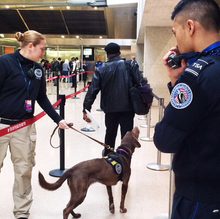This article has multiple issues. Please help improve it or discuss these issues on the talk page. (Learn how and when to remove these messages)
|

The National Explosives Detection Canine Team Program is a program administered by the Transportation Security Administration which uses law enforcement and TSA-run explosives detection dog teams to detect explosives in transportation environments.
History
The program was originally started in 1972 by the TSA's predecessor, the Federal Aviation Administration, who at the time, was responsible for aviation security in the United States. The program paired airport-based law enforcement officers with conventional explosive detection canines to detect explosives in objects such as vehicles and baggage.
Following the September 11th attacks, which resulted in the creation of TSA, the NEDCTP was transferred from the FAA to TSA and was completed by March 2003. In the following years, TSA expanded the LEO teams to other modes of transportation, such as mass transit. In January 2008, TSA began deploying their own unarmed teams where regulatory transportation security inspectors (TSIs) were paired with a canine to screen air cargo. In 2011, TSA furthered the program by launching passenger screening canine (PSC) teams, which are explosive detection canines who besides detecting explosives in objects, can also detect explosives hidden on a person.
Canines and training
TSA sources their canines from the Department of Defense Military Working Dog program. The canines are trained at TSA's Canine Training Center, located at Lackland Air Force Base in San Antonio, Texas, also home to DOD's Military Working Dog program.
TSA uses the following breeds of canine for explosive detection work:
- Belgian Malinois
- German Shepherd
- German Shorthaired Pointer
- German Wirehaired Pointer
- Golden Retriever
- Labrador Retriever
- Vizsla
There are two types of explosive detection canines trained by TSA:
- Conventional explosive detection canines (EDC) who undergo a 10-week training course accompanied by either an assigned LEO or TSA handler. EDCs are trained to recognize explosive odors coming from baggage and vehicles.
- Passenger screening canines (PSC) who undergo a 12-week training course accompanied by their TSA handler. PSCs are trained to recognize explosive odors on passengers plus odors from objects as an EDC does.
TSA operates 372 canine teams consisting of a Transportation Security Specialist - Explosive Detection Canine Handler (TSS-EDCH) and a canine. Prior to 2017, the handler was classified as a Transportation Security Inspector - EDCH. The remaining 675 NEDCTP teams are made up of state and local law enforcement handlers.
References
- ^ "EXPLOSIVES DETECTION CANINES : TSA Has Enhanced Its Canine Program, but Opportunities May Exist to Reduce Costs" (PDF). GAO.gov. Government Accountability Office. March 3, 2016. Retrieved 30 October 2017.
- ^ Hutchinson, Kimberly (March 3, 2016). "Dogs of DHS: How Canine Programs Contribute to Homeland Security". TSA.gov. Transportation Security Administration. Retrieved October 30, 2017.
- ^ Harvey, Melanie (May 18, 2017). "From the Border to Disasters and Beyond: Critical Canine Contributions to the DHS Mission". TSA.gov. Transportation Security Administration. Retrieved October 30, 2017.
- ^ "TSA EXPLOSIVES DETECTION CANINE PROGRAM : Actions Needed to Analyze Data and Ensure Canine Teams Are Effectively Utilized" (PDF). GAO.gov. Government Accountability Office. January 31, 2013. Retrieved 30 October 2017.
- ^ "TSA Canine Training Center Factsheet" (PDF). TSA.gov. Transportation Security Administration. Retrieved November 2, 2017.